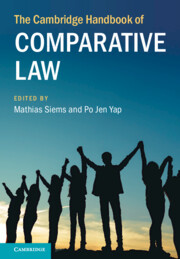Book contents
- The Cambridge Handbook of Comparative Law
- The Cambridge Handbook of Comparative Law
- Copyright page
- Contents
- Figures
- Tables
- Contributors
- Preface
- Abbreviations
- 1 Introduction
- Part I Methods of Comparative Law
- Part II Legal Families and Geographical Comparisons
- Part III Central Themes in Comparative Law
- Part IV Comparative Law beyond the State
- 28 Comparative International Law
- 29 Transnational Regulation
- 30 Quantitative Forms of Legal Governance
- 31 Comparative International Arbitration Law
- 32 Cross-Border Judicial Dialogue
- 33 Comparing Regional Law
- 34 Comparative Conflict of Laws
- 35 Comparative Indigenous Law
- 36 Comparative Legal Education
- Index
28 - Comparative International Law
from Part IV - Comparative Law beyond the State
Published online by Cambridge University Press: 26 January 2024
- The Cambridge Handbook of Comparative Law
- The Cambridge Handbook of Comparative Law
- Copyright page
- Contents
- Figures
- Tables
- Contributors
- Preface
- Abbreviations
- 1 Introduction
- Part I Methods of Comparative Law
- Part II Legal Families and Geographical Comparisons
- Part III Central Themes in Comparative Law
- Part IV Comparative Law beyond the State
- 28 Comparative International Law
- 29 Transnational Regulation
- 30 Quantitative Forms of Legal Governance
- 31 Comparative International Arbitration Law
- 32 Cross-Border Judicial Dialogue
- 33 Comparing Regional Law
- 34 Comparative Conflict of Laws
- 35 Comparative Indigenous Law
- 36 Comparative Legal Education
- Index
Summary
One of the main characteristics of international law is its claim to ‘universality’. International law’s body of rules and practices is generally supposed to apply to every state and individual member of the world. This chapter challenges the perception that international law cannot be viewed through comparative lenses, as well as the idea that legal comparativism is a set of methodologies to contrast only domestic and regional legal systems and concepts. The underlying argument of the chapter is that behind common rules and shared aspirations of principles, members of an international system may adopt very different approaches, doctrines and procedures of internalisation. That invites an important role for comparativism. The chapter exemplifies this broad research agenda through a panoramic analysis of international human rights law and international environmental law, in both cases looking at foreign relations law and its constituencies in different legal realities.
Keywords
- Type
- Chapter
- Information
- The Cambridge Handbook of Comparative Law , pp. 561 - 574Publisher: Cambridge University PressPrint publication year: 2024

